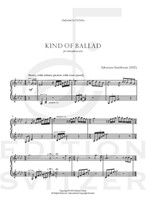
Kind of Ballad
Composer: Johannes Steinbauer
Instrument: Vibraphone
Level: Easy/Intermediate
Published: 2022
Price: €16.00
Item details
-
Description +
-
Duration: approx. 6 min.
Preface
KIND OF BALLAD is a piece for vibraphone solo that is dedicated to my neighbours and friends Olivia, Dagmar and Kurt. Thanks!
It should be played with great interpretative freedom. For this reason, no markings regarding dynamics or (exact) tempo have been included.
I wish all vibraphonists a lot of fun and success with KIND OF BALLAD.
Special thanks to Matti Opiola for the wonderful interpretation and Thorsten Blumberg for the professional and creative production of the presentation video.
-
-
Instrumentation +
-
Vibraphone
-
-
Watch+
-
Performed by Matti Opiola
-
-
About the composer +
-
Johannes Steinbauer was born in 1973 in Bavaria (Germany) and started drumming in a brass band at the age of 11. Later, he was taught by Christian Obermaier, who laid the groundwork for his professional training.
In 1993, whilst studying with Prof. Arnold F. Riedhammer at the „Richard Strauss Konservatorium“ in Munich, Johannes Steinbauer won a position as percussionist in the „Beethoven Orchester Bonn“. In 2001 he was appointed Principal Percussionist of the „WDR Sinfonieorchester Köln“.
Studies for snare drum and percussion were written in 2019, based on decades of orchestral experience. In 2020, Johannes Steinbauer composed his first solo pieces, including the 2020 Solo Trilogy for Vibraphone and Percussion, which was produced by the Westdeutscher Rundfunk, Cologne in 2021.
For more information, please visit www.charakter-etueden.de
-
-
Reviews +
-
Percussive Notes, April 2023
German percussionist and composer Johannes Steinbauer brings us this new solo ballad for vibraphone. It is a beautiful piece with some rhythmic and technical elements that can challenge a young player, but with enough written-in wiggle-room to meet those challenges. This would also be great for seasoned veterans to display their expressiveness.
“Kind of Ballad” can be separated into three major sections: the introduction, the melody, and the outro. The first 23 measures are a notated improvisation, including runs up and down the instrument in quintuplets, septuplets, nontuplets, as well as more common rhythms. We also see a few different time signatures employed, such as 8/4, 5/4, and one measure of 9/8. Although this looks overly complicated, this entire section is meant to be played freely and with much rubato, making it much more approachable than initially perceived. This is another example of the irony of notated improvisation: freedom on paper looks complicated.
After the first third of the piece, we enter thesingable section of the composition. This is noticeably less complicated, being made up of simple melodic ideas, similar harmonic language as the opening, and one unchanging meter. The final phrases of the main tune elide smoothly into the outro, which includes the last statements of the melody played at the highest register of the vibraphone. Here also, the performer brings back the expressive rubato of the intro, which is used to make the final gestures get slower and slower until the end, as if the lights on the performance are gradually fading to black.
Outside of the rhythmic complexity of the introduction, this piece is not complicated. It would be a great work for a young player who wants to delve into a four-mallet jazz ballad and work on such techniques as different types of dampening, since there are no pedal markings. One of the most enjoyable aspects is how storylike it is — the scene and atmosphere shaped by the detailed introduction, the monologue expressed in the melody of the middle section, and ending with the gradual exit of the orator as they slowly disappear into the night. This is truly a composition that performers at all levels can enjoy and make their own.
—Kyle Cherwinski
-
-
Credits +
-
Front Cover Artwork: Nicola Lee Photo:
Thorsten Blumberg
Translation: Dan Townsend
Engraving: Johannes Steinbauer
Printed in Copenhagen, Denmark
Copyright © Edition SVITZER
www.editionsvitzer.com
-





